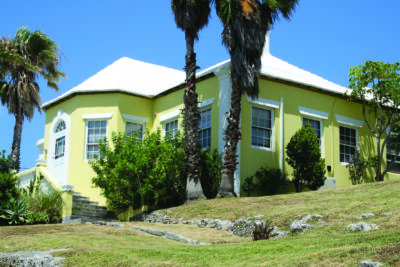Location: Royal Naval Dockyard, Sandys
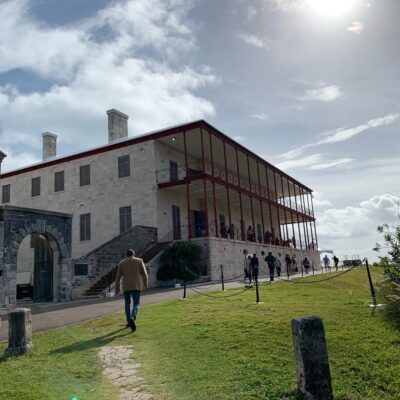 When the American Revolution deprived Britain of access to the ports of its former colonies on the eastern seaboard of America, it soon became obvious that Bermuda was ideally located to connect the British possessions in Canada and the West Indies.
When the American Revolution deprived Britain of access to the ports of its former colonies on the eastern seaboard of America, it soon became obvious that Bermuda was ideally located to connect the British possessions in Canada and the West Indies.
In 1795 a base was commissioned at St. George’s, and in 1809 the Royal Navy acquired Ireland Island in the west end for the creation of a dockyard which would become the main British naval base in the western North Atlantic. The function of naval dockyards such as those at Gibraltar and Malta was essentially a civilian one: to repair and re-arm ships, to supply them with food, gunpowder and everything else they required as they patrolled the seas to protect the growing British Empire.
Building such a complex in Bermuda became important for the local economy, and ore then 1,000 Bermudians were employed in these civilian capacities at the height of operations in the 19th century. Because these functions were critical to the fleet, they were surrounded by heavy fortifications. In Bermuda, the fortifications surrounded the Dockyard on the three sides, with the major fort of the Keep at the northern end.
The first building constructed in the Keep was the Commissioner’s House. Designed as a prototype for buildings which would withstand the inhospitable climates of naval stations around the globe, a cast iron structural frame was fabricated in England and shipped to Bermuda for assembly. This sturdy construction, combined with hard Walsingham limestone, made Commissioner’s House a building that could withstand virtually anything. This experimental building is believed to have been first use of prefabricated cast iron in domestic architecture.
Much of Dockyard was built with convict labour, and more than 9,000 convicts were brought to Bermuda and housed in ships’ hulks. During the yellow fever epidemic of 1853, over 2,000 of them died here and were buried on Watford Island. In 1863 the last of the convicts were sent home or to Australia. The Keep saw service through two world wars in the 20th century, and was decommissioned in 1951 when it was bought by the Government of Bermuda. For many years it was left to deteriorate, along with other buildings in Dockyard. In 1974 Dr. Jack Arnell and Mr. Andrew Trimingham, leading a committee of the National Trust, succeeded in their campaign to convert the Keep into a maritime museum. The Government leased the Keep to the National Trust for 99 years, and the Trust has leased it to the Bermuda National Museum.
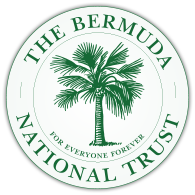
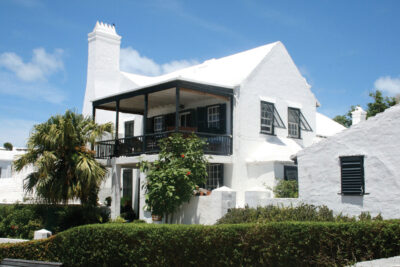 Bridge House was originally a timber framed two-storey house built by Roger Bailey, a planter and shoemaker. We do not know its construction date, but it was certainly there by the time of Richard Norwood’s 1662-63 survey. In 1702, it was purchased by Captain John Fflolett and his wife Jane. They embarked on major reconstruction of the house in stone, but they did not live to see it completed in 1708. The refitting was certainly grand enough for the sixth Crown governor, Benjamin Bennett, who lived there from 1709 probably until his death in 1736. It has changed little since. Today’s name for the house is thought to refer to a bridge which used to exist nearby.
Bridge House was originally a timber framed two-storey house built by Roger Bailey, a planter and shoemaker. We do not know its construction date, but it was certainly there by the time of Richard Norwood’s 1662-63 survey. In 1702, it was purchased by Captain John Fflolett and his wife Jane. They embarked on major reconstruction of the house in stone, but they did not live to see it completed in 1708. The refitting was certainly grand enough for the sixth Crown governor, Benjamin Bennett, who lived there from 1709 probably until his death in 1736. It has changed little since. Today’s name for the house is thought to refer to a bridge which used to exist nearby.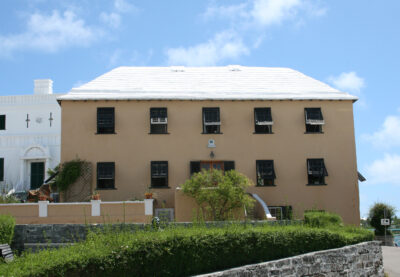 Built around 1750 by Samuel Mills, who bought the lot for just five pounds, Buckingham remains largely unchanged – a rather plain two-storey Georgian house. Mills and his wife Sarah lived there with their sons Samuel and Thomas Burt. A kitchen wing was added to the north of the house during the 1860s. Samuel Crofts Rankin bought the house in 1901 and named it Buckingham. The name may have been intended to complement another property he owned called Windsor.
Built around 1750 by Samuel Mills, who bought the lot for just five pounds, Buckingham remains largely unchanged – a rather plain two-storey Georgian house. Mills and his wife Sarah lived there with their sons Samuel and Thomas Burt. A kitchen wing was added to the north of the house during the 1860s. Samuel Crofts Rankin bought the house in 1901 and named it Buckingham. The name may have been intended to complement another property he owned called Windsor.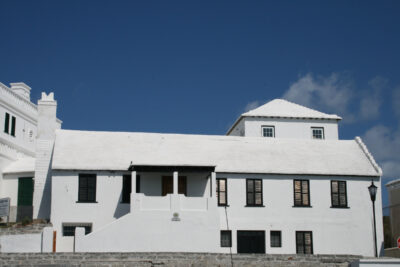
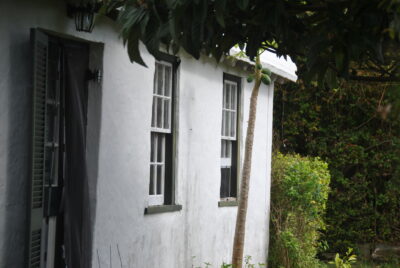
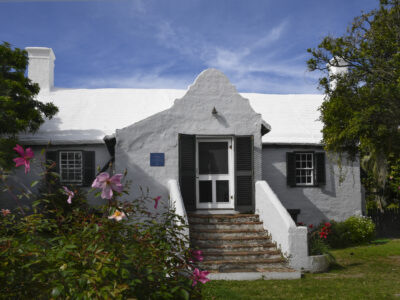 The Old Rectory was built by Captain George Dew around 1699, making it one of the oldest surviving houses in Bermuda. It is most notable for its asymmetric protruding porch room with its welcoming arms steps. The original building comprised the hall and chamber front section, and possibly the porch room. Although it was never owned by the church, nor was the official rectory, the house got its name from a previous owner, Reverend Alexander Richardson, rector of St. George’s, who was nicknamed ‘The Little Bishop’.
The Old Rectory was built by Captain George Dew around 1699, making it one of the oldest surviving houses in Bermuda. It is most notable for its asymmetric protruding porch room with its welcoming arms steps. The original building comprised the hall and chamber front section, and possibly the porch room. Although it was never owned by the church, nor was the official rectory, the house got its name from a previous owner, Reverend Alexander Richardson, rector of St. George’s, who was nicknamed ‘The Little Bishop’.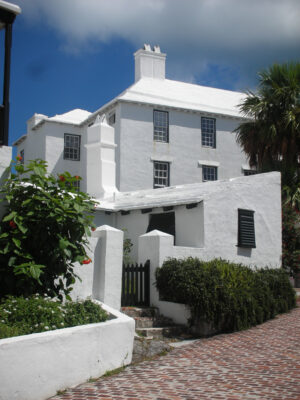 Reverend Thomas Holland built Reeve Court in 1705. However, one year later he and his wife Elizabeth left Bermuda for Virginia. They sold the house to Samuel Smith, who was a Colonel, Judge, Collector of Customs and member of the Governor’s Council. His son and grandchildren lived in the home for the next 50 or so years. It was purchased by Dr. Richard Tucker by 1760 and his daughter Elizabeth, married the merchant Thomas Reeve, from whom the house takes its name. Reeve Court is significantly larger than most buildings in St. George’s and was for centuries the tallest building in the town.
Reverend Thomas Holland built Reeve Court in 1705. However, one year later he and his wife Elizabeth left Bermuda for Virginia. They sold the house to Samuel Smith, who was a Colonel, Judge, Collector of Customs and member of the Governor’s Council. His son and grandchildren lived in the home for the next 50 or so years. It was purchased by Dr. Richard Tucker by 1760 and his daughter Elizabeth, married the merchant Thomas Reeve, from whom the house takes its name. Reeve Court is significantly larger than most buildings in St. George’s and was for centuries the tallest building in the town.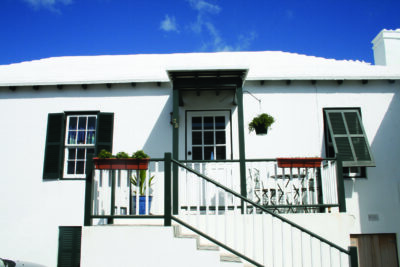 The Samaritans’ Cottages are excellent examples of early 18th century cottages in the prevailing architectural style of St. George’s when the town was rebuilt in stone after the hurricane of 1686. The eastern cottage possibly dates back as early as 1676, when William Pearman purchased a building on the site. The western cottage was built by Pearman’s daughter Martha and her husband Thomas Handy in 1719. This particular plot was owned by accused witch Margery Potter, who was cleared in 1693 of the charge of casting spells on one John Middleton. The two cottages remained under separate ownership until 1786.
The Samaritans’ Cottages are excellent examples of early 18th century cottages in the prevailing architectural style of St. George’s when the town was rebuilt in stone after the hurricane of 1686. The eastern cottage possibly dates back as early as 1676, when William Pearman purchased a building on the site. The western cottage was built by Pearman’s daughter Martha and her husband Thomas Handy in 1719. This particular plot was owned by accused witch Margery Potter, who was cleared in 1693 of the charge of casting spells on one John Middleton. The two cottages remained under separate ownership until 1786.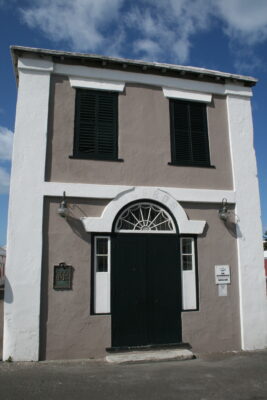
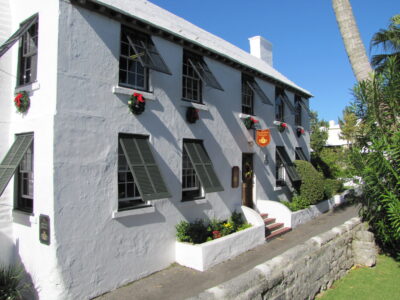
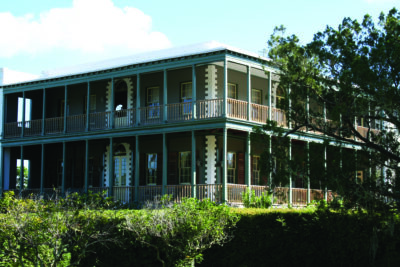 On more than two acres on Cobbs Hill Road overlooking Hamilton Harbour is Belair – a unique example in Bermuda of a West Indian plantation house. Surrounded by wide balconies, with a shallow sloping roof and extensive cellars, quoining It was built around 1815 by Francis Albouy who was a successful businessman in Demerara. He eventually returned to Bermuda where he served as a member of the Governor’s Council for many years. It remained in the Harvey family until 1900 and is now let on a long lease.
On more than two acres on Cobbs Hill Road overlooking Hamilton Harbour is Belair – a unique example in Bermuda of a West Indian plantation house. Surrounded by wide balconies, with a shallow sloping roof and extensive cellars, quoining It was built around 1815 by Francis Albouy who was a successful businessman in Demerara. He eventually returned to Bermuda where he served as a member of the Governor’s Council for many years. It remained in the Harvey family until 1900 and is now let on a long lease.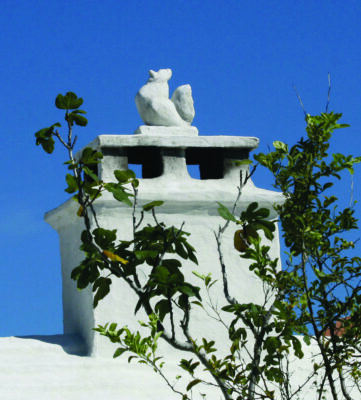 Cluster Cottage is an early 18th century house which survives remarkably unaltered as an excellent example of early Bermuda domestic architecture. Parts of the house could date back to as early as the 17th century but the main east/west section probably dates from the early 18th century and the southern wings from the middle of that century. It has sturdy garden walls, a wooden porch and windows positioned close under the eaves. All the rooms have tray ceilings joined at each corner with a natural cedar knee. It is believed that the cellar space beneath the cottage was used as quarters for the enslaved people who lived there.
Cluster Cottage is an early 18th century house which survives remarkably unaltered as an excellent example of early Bermuda domestic architecture. Parts of the house could date back to as early as the 17th century but the main east/west section probably dates from the early 18th century and the southern wings from the middle of that century. It has sturdy garden walls, a wooden porch and windows positioned close under the eaves. All the rooms have tray ceilings joined at each corner with a natural cedar knee. It is believed that the cellar space beneath the cottage was used as quarters for the enslaved people who lived there.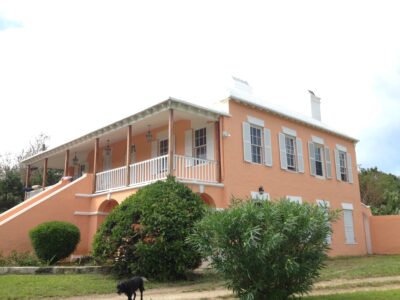
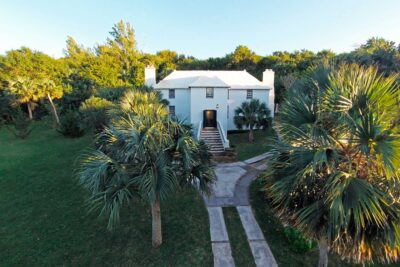
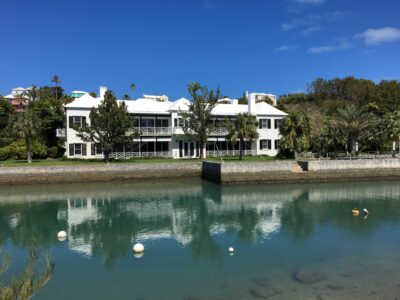 Pembroke Hall is an elegant building set in manicured gardens at the entrance to Hamilton. The original U-shaped house was built in the late 18th or early 199th century. The house is set on a slope and the single-storey wing on the north side, with its old hipped roofs and pilasters, is the least altered part of the building today. Cornelius Hinson owned the land all the way over to the North Shore at the time of his death in 1789 but it is likely that the present house was built by a later owner, Richard Wood who bought the property from Hinson’s heirs in 1820 for his daughter Frances Russell Wood and her husband Joseph Dill. The Dills’ daughter Frances and her husband Thomas Reid inherited it. Mrs Reid’s brother, Lucas Dill, was a merchant in the West Indies and brought back many exotic trees which grace the grounds to this day. When Frances Reid died in 1913 she left the house to her cousin Lieutenant Thomas Dill, but the bulk of her fortune went to the Bermuda Cathedral endowment fund. For some of this period, the house was operated as a guest house. When Colonel Dill died in 1945, the property was left to his daughters. In 1981 Fidelity International bought the house, giving the freehold to the Trust, and retaining a long lease on the property. Fidelity undertook a careful restoration and expansion of the house for use as their international headquarters. They restored the original façade, preserving the hipped roof and pilasters, meticulously restoring the woodwork in the reception rooms and adding a sympathetic extension at the rear. The old fishpond on the site has been preserved, and recently the boathouse was rehabilitated.
Pembroke Hall is an elegant building set in manicured gardens at the entrance to Hamilton. The original U-shaped house was built in the late 18th or early 199th century. The house is set on a slope and the single-storey wing on the north side, with its old hipped roofs and pilasters, is the least altered part of the building today. Cornelius Hinson owned the land all the way over to the North Shore at the time of his death in 1789 but it is likely that the present house was built by a later owner, Richard Wood who bought the property from Hinson’s heirs in 1820 for his daughter Frances Russell Wood and her husband Joseph Dill. The Dills’ daughter Frances and her husband Thomas Reid inherited it. Mrs Reid’s brother, Lucas Dill, was a merchant in the West Indies and brought back many exotic trees which grace the grounds to this day. When Frances Reid died in 1913 she left the house to her cousin Lieutenant Thomas Dill, but the bulk of her fortune went to the Bermuda Cathedral endowment fund. For some of this period, the house was operated as a guest house. When Colonel Dill died in 1945, the property was left to his daughters. In 1981 Fidelity International bought the house, giving the freehold to the Trust, and retaining a long lease on the property. Fidelity undertook a careful restoration and expansion of the house for use as their international headquarters. They restored the original façade, preserving the hipped roof and pilasters, meticulously restoring the woodwork in the reception rooms and adding a sympathetic extension at the rear. The old fishpond on the site has been preserved, and recently the boathouse was rehabilitated.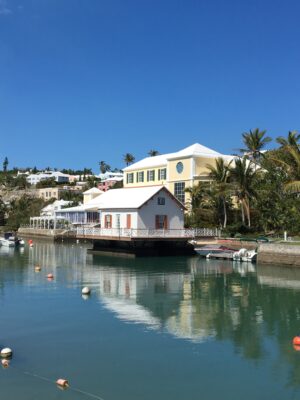
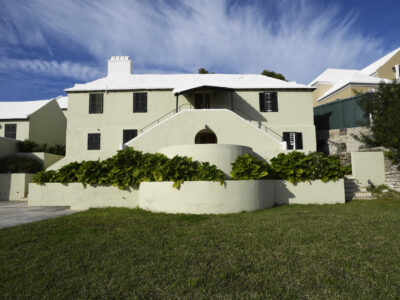 Situated in Pembroke are these three small houses which feature beautiful chimneys, an elegant buttery and an unusual set of lateral steps of a style normally found only in St. George’s. It was in the largest of these houses that as an enslaved woman, Mary Prince endured cruel treatment at the hands of ‘Captain I’ and his wife. Originally it was thought that these cottages had been built on so-called School Lands to generate income for the education of poor children. This is not so, as School Lands were further east. Mary’s description in her famous narrative of 1831 leave little doubt that this was the house in which she spent some miserable years.
Situated in Pembroke are these three small houses which feature beautiful chimneys, an elegant buttery and an unusual set of lateral steps of a style normally found only in St. George’s. It was in the largest of these houses that as an enslaved woman, Mary Prince endured cruel treatment at the hands of ‘Captain I’ and his wife. Originally it was thought that these cottages had been built on so-called School Lands to generate income for the education of poor children. This is not so, as School Lands were further east. Mary’s description in her famous narrative of 1831 leave little doubt that this was the house in which she spent some miserable years.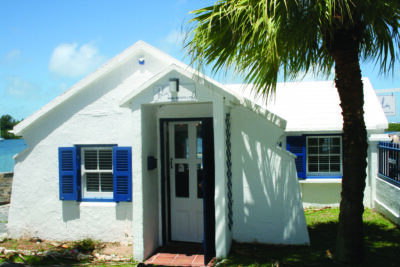
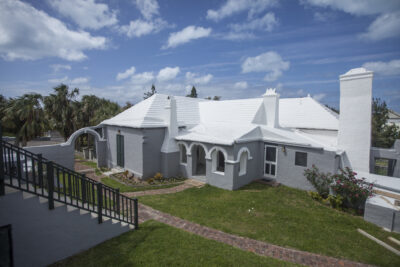 The Springfield estate remained the property of the Hinson families until it was purchased by the Historical Monuments Trust in 1966. The founder, Edward Hinson, was on the property by 1662. Prior to Springfield, we know there was a substantial two-storey post and plaster house with a thatched roof on the site. Edward left the property to his daughter Mary and it was she and husband Ephraim Gilbert who during the 1740s built the main part of today’s structure. The house was subsequently enlarged during the late 1700s, with the addition of the courtyard, slave house, a kitchen and the unusual smooth-roofed buttery, as well as additional rooms to the house.
The Springfield estate remained the property of the Hinson families until it was purchased by the Historical Monuments Trust in 1966. The founder, Edward Hinson, was on the property by 1662. Prior to Springfield, we know there was a substantial two-storey post and plaster house with a thatched roof on the site. Edward left the property to his daughter Mary and it was she and husband Ephraim Gilbert who during the 1740s built the main part of today’s structure. The house was subsequently enlarged during the late 1700s, with the addition of the courtyard, slave house, a kitchen and the unusual smooth-roofed buttery, as well as additional rooms to the house.
